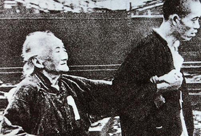 Martenitsa adds glamour to Bulgarian Embassy
Martenitsa adds glamour to Bulgarian Embassy
 Mysterious 'Dolan Tribe' in Xinjiang
Mysterious 'Dolan Tribe' in Xinjiang
 This is Shanghai
This is Shanghai
 Female attendants serving 'two sessions'
Female attendants serving 'two sessions'
 The many tears of DiCaprio
The many tears of DiCaprio
 Dan Dan's bittersweet opera life
Dan Dan's bittersweet opera life
 A dream wedding for a girl suffering from cancer
A dream wedding for a girl suffering from cancer
 Old photos of Anti-Japanese War (1937-1945)
Old photos of Anti-Japanese War (1937-1945)
 This is Beijing – Nanluoguxiang
This is Beijing – Nanluoguxiang
BEIJING, March 10 -- As the mayor of China's southernmost and youngest city, Xiao Jie is eager for growth and has made a lot of demands during the ongoing national parliamentary meeting.
Xiao hoped that Sansha City, founded in mid 2012 with the smallest land area and largest sea area among Chinese cities, would soon see better airports and ports, locally-registered firms, as well as booming trade and more cooperation with international counterparts.
There might just be a road leading to his city's prosperity.
Chinese Premier Li Keqiang highlighted accelerating the construction of the Maritime Silk Road in the government work report last Wednesday, an initiative that will further boost coastal cities' economies.
Wang Lu, member of the Chinese People's Political Consultative Conference (CPPCC) and deputy governor of Hainan Province, has also been seeking new growth momentum for the island.
He brought several proposals to the parliamentary meeting, including allowing exchange trade between border residents, developing cruise tourism around the South China Sea and expanding fishery cooperation.
Since ancient times, Southeast Asia has been an important hub along the historical Maritime Silk Road, a commercial route on which China sold its silk and other commodities to other countries.
The idea of the 21st Century Maritime Silk Road was proposed by Chinese President Xi Jinping during his visit to Indonesia last year, a mutual-benefit-seeking initiative echoed by the Association of Southeast Asian Nations (ASEAN), Russia and other stakeholders.
The historical Maritime Silk Road mainly served as a one-way trade channel, but the updated route focuses more on interaction and mutual benefit, said Xiang Xiaomei, member of CPPCC and an industrial economics expert from south China's Guangdong Province.
The cooperation will cover more areas, from commodity trade to whole industrial chain partnerships and cultural exchanges, she added.
The initiative is already on the road.
China and the ASEAN are working together to update the bilateral free trade zone. Bilateral trade volume and new investment are expected to reach 1 trillion and 15 million U.S. dollars respectively in 2020.
"It is not just about opening up for economic exchanges; it is a platform to hone one's overall competitiveness," Xiang said.
Meanwhile, session attendees argue that the initiative should take a greener road to protect the marine ecosystem.
China and other countries should work together in marine sustainability, and countering illegal resource-damaging activities, said Luo Shaming, a CPPCC member.
There are likely to be a few bumps ahead for the new Maritime Silk Road.
In addition to inconvenient transportation, trade and investment barriers persist due to different laws and regulations of various countries.
Meanwhile, territorial disputes over the East China Sea and South China Sea have cast doubts over the aim and prospects of the initiative.
Building overland and maritime silk roads will help boost the renewal of Asia by the further opening-up of China, especially in the westward direction, Chinese Foreign Minister Wang Yi said last week.
The focus would be on economic cooperation and people-to-people cultural exchanges, and prioritizing connectivity and simplifying trade and investment, Wang said.
To ease concerns, Xiang Xiaomei called for more involvement of enterprises and ordinary people in enhancing exchanges, which needs the acceleration of infrastructure development such as ports to beef up connectivity.
"Then leave trade and investment activities to the market, and the government should facilitate market-based capital and talent flow with preferential policies," she said.
 Chaihe village, pure and peaceful fairyland in snow
Chaihe village, pure and peaceful fairyland in snow Belgians warmly welcome arrival of China's giant pandas
Belgians warmly welcome arrival of China's giant pandas Female marines receive tactical training in NW China
Female marines receive tactical training in NW China Blood memory: Nanjing Massacre in 1937
Blood memory: Nanjing Massacre in 1937 Top 10 pure beauties in showbiz
Top 10 pure beauties in showbiz British WWII veteran: I can't forgive Japan
British WWII veteran: I can't forgive Japan Tongban's dream of prosperity
Tongban's dream of prosperity Chinese frigate Yancheng holds drills in Mediterranean Sea
Chinese frigate Yancheng holds drills in Mediterranean Sea A visit to comfort woman's home in South Korea
A visit to comfort woman's home in South Korea Fairyland? Qingdao in sea of clouds
Fairyland? Qingdao in sea of clouds Top 10 most handsome faces in Asia in 2013
Top 10 most handsome faces in Asia in 2013 Female celebs with beautiful long legs
Female celebs with beautiful long legs Cat 'guardians' in Forbidden City
Cat 'guardians' in Forbidden City Large numbers of ancient coins excavated in Inner Mongolia
Large numbers of ancient coins excavated in Inner Mongolia Leisurely life beneath Zhonggulou, where time travels slower
Leisurely life beneath Zhonggulou, where time travels slowerDay|Week|Month